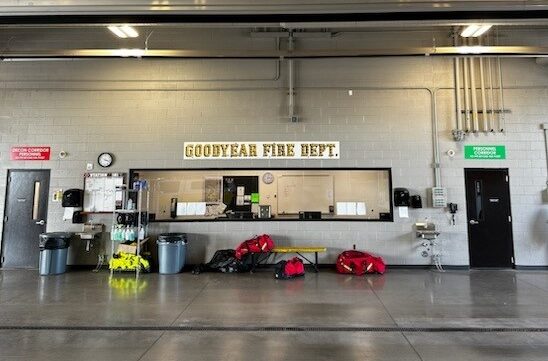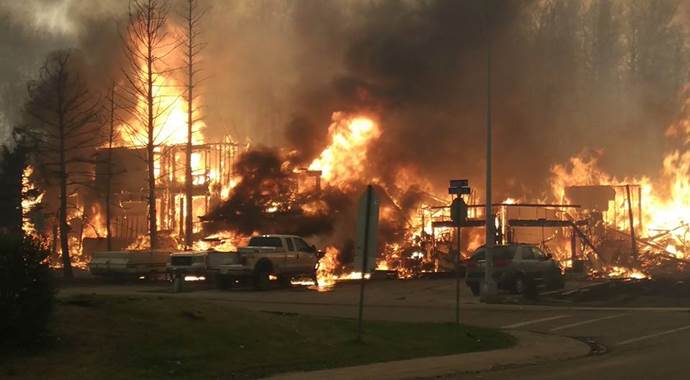
In a pioneering effort to prioritize the well-being of its fire fighters, Goodyear Fire Department and the United Goodyear Fire Fighters Association introduced an innovative approach with the opening of Station 181. This state-of-the-art facility not only stands as a testament to a commitment to fire fighter well-being but also serves as a memorial to fallen Goodyear fire engineer and Goodyear, AZ Local 4005 member Austin Peck, who succumbed to occupationally contrived sinus cancer in 2019 at the age of 35.
“Austin died of occupational cancer, and this was really on the backs of when the science surrounding the dangers of PFAS for fire fighters was just starting to become more widely dispersed nationally,” said Local 4005 President Dan Freiberg. “So that was the impetus for us to put in so many cancer mitigation practices. Not only with the design and the architecture of our building but also with evaluating our policies – how we decontaminate (decon), what we do with our equipment in the firehouse and on the fireground.”
In December 2019, Goodyear City Council approved funding for the construction of two new fire stations. The visionary design of Station 181, created by fire fighters for fire fighters, incorporates innovative safety features with a focus on the long-term health of fire fighters.
“At Station 181, we have some of Austin’s ashes built into our foundation,” said Freiberg. “We have a spot where he is memorialized and whenever we give a tour of that station, which happens a lot, we start at that location.”
Key features of the new stations include a dedicated decontamination corridor, which allows fire fighters to decontaminate their turnout gear as soon as they return to the fire station and a strategically designed vestibule separating the “clean” (living) side of the station marked with green signs and the “dirty” (business) side of the station marked with red signs. Fire fighters returning from a call are guided through the “dirty” zone through a targeted approach directing fire fighters into designated shower facilities to prevent potential exposure to contaminants.
Recognizing the challenges posed by Arizona’s intense temperatures, the station features a shade structure outside the apparatus bay, providing relief for fire fighters. It also includes direct access to the decontamination room. Accessible from the outside, an extractor capable of handling four sets of turnouts expedites the decontamination process, ensuring a swift return to service.
“We can walk up to that room, grab our second set of turnouts, and throw it on the engine,” said Freiberg. “Then everybody is instructed to keep your second ensemble ready to go to minimize our out-of-service time while in decon.”
Goodyear is also one of the first few cities in the nation to adopt a clean cab process aimed to keep carcinogens away from fire fighters.
“It is important for stations to have designated hot and cold zones to reduce the spread of fireground contaminants brought back to the station,” said Racquel Cesnalis, IAFF Deputy Director of Occupational Health and Medicine. “Research has demonstrated that there are hundreds of fireground contaminants that fire fighters are exposed to when they respond to a fire, and even with on-scene preliminary exposure reduction where many contaminants are removed from gear and equipment; these efforts do not remove 100% of the contaminants so additional precautions are needed.”
As Goodyear remains at the forefront of adopting these life-saving measures, Freiberg says it’s important to continue engaging in local, state, and national politics, while actively building relationships and connections.
“We have incredible relationships with our Goodyear Fire Department and the City of Goodyear management,” said Freiberg. “We have also built relationships with the business community through our charitable efforts and political presence. This proves invaluable during the budget process, especially when advocating for a fire station we know is costly to build,” he said.
Freiberg says in the end, they’re working toward providing additional cancer prevention measures at fires stations across the city to help save lives. “Our mission is clear – taking care of each other. In Goodyear, our Local has faced significant cancer challenges among individuals in their 20s and 30s. Despite the difficulty, we prioritize proactive action over waiting for guidance. Building relationships is key to making safety a reality based on our experiences and observations.”
Visit the link to view a tour of Station 181.
To learn more about Fire Fighter Cancer Awareness month, research, cancer prevention in action, survivor stories, and early detection tips, visit the link here. For more information on best practices to reduce exposure and fire station design, visit the link here.






